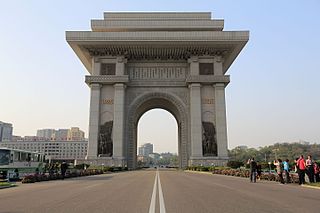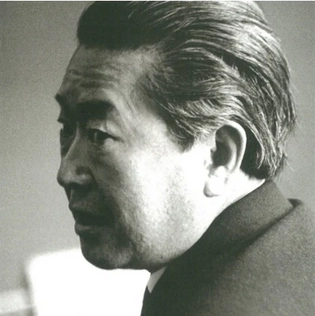Contents
 |
| Part of a series on the |
| Culture of Korea |
|---|
| Society |
| Arts and literature |
| Other |
| Symbols |
|
This is a list of museums in North Korea.
 |
| Part of a series on the |
| Culture of Korea |
|---|
| Society |
| Arts and literature |
| Other |
| Symbols |
|
This is a list of museums in North Korea.

Pyongyang is the capital and largest city of the Democratic People's Republic of Korea (DPRK), commonly known as North Korea, where it is sometimes labeled as the "Capital of the Revolution". Pyongyang is located on the Taedong River about 109 km (68 mi) upstream from its mouth on the Yellow Sea. According to the 2008 population census, it has a population of 3,255,288. Pyongyang is a directly administered city with a status equal to that of the North Korean provinces.

The contemporary culture of North Korea is based on traditional Korean culture, but has developed since the division of Korea in 1945. The Juche ideology conceived by Kim Il Sung (1948–1994) asserts Korea's cultural distinctiveness and creativity, as well as the productive powers of the working masses.

Kim Il Sung University (Korean: 김일성종합대학) is a university in Taesong, Pyongyang, North Korea. Founded on 1 October 1946, it is the first institution of higher learning in North Korea since its foundation.

The Down-with-Imperialism Union was allegedly founded on 17 October 1926 in Hwatian County, Kirin, China, in order to fight against Japanese imperialism and to promote Marxism–Leninism. It is considered by the Workers' Party of Korea to be its root and foundation and its creation is celebrated every year.

Kim Jong Suk was a Korean anti-Japanese guerrilla, a Communist activist, North Korean leader Kim Il Sung's first wife, former leader Kim Jong Il's mother, and current leader Kim Jong Un's grandmother.

Moranbong or Moran Hill forms a park located in central Pyongyang, the capital of North Korea. Its 312-foot (95 m) summit is the location of the Pyongyang TV Tower.

Pak Song-chol or Park Sung-chul was a North Korean politician who served as Premier of North Korea from 1976 to 1977. He succeeded Kim Il. He also served as foreign minister from 1959 to 1970.
O Jin-u was a North Korean general and politician. He was a close associate of Kim Il Sung. O served under Kim in the Northeast Anti-Japanese United Army, and then as commander of Kim's bodyguard. He was a founding officer of the Korean People's Army (KPA), fought in the Korean War, and was a Vice-Chairman of the National Defence Commission from 1972 until dying in 1995. He was considered to be the most powerful person in North Korea after Kim Il Sung and Kim Jong Il, a hardliner, and a strong supporter of North Korea's nuclear program.

The Mansudae Art Studio is an art studio in Pyeongcheon District, Pyongyang, North Korea. It was founded in 1959, and it is one of the largest centers of art production in the world, at an area of over 120,000 square meters. The studio employs around 4,000 people, 1,000 of whom are artists picked from the best academies in North Korea. Most of its artists are graduates of Pyongyang University. The studio consists of 13 groups, including those for woodcuts, charcoal drawings, ceramics, embroidery and jewel paintings, among other things.

The Party Founding Museum is a museum located in the Central District of Pyongyang, North Korea, on the south side of Mt. Haebang The building was constructed by the Japanese occupation government in 1923. It was used as the South P'yŏngan Provincial Products Exhibition. Thus, in October 1970 it was turned into a museum dedicated to his exploits. Nearby, and also part of the museum, is the modest house he inhabited during his early days as president of North Korea.

Kim Il Sung died of a sudden heart attack on the early morning of 8 July 1994 at age 82. North Korea's government did not report the death for more than 34 hours after it occurred. An official mourning period was declared from 8–17 July, during which the national flag was flown at half mast throughout the country, and all forms of amusement and dancing were prohibited.

Pen Varlen was a Soviet Russian-Korean painter and graphic artist.

The Korean Revolution Museum (Korean: 조선혁명박물관), located in Pyongyang, North Korea, was founded on August 1, 1948, and holds a large exhibition of items related to Kim Il Sung and the Korean revolutionary movement. It is situated behind the Mansu Hill Grand Monument and is adjacent to the Mansudae Assembly Hall, seat of the Supreme People's Assembly, the North Korean legislature.

The Victorious War Museum, or the Victorious Fatherland Liberation War Museum, is a history/military museum dedicated to the Korean War located in the North Korean capital-city of Pyongyang.

The Three Revolutions Exhibition is a museum located in North Korea. The exhibition primarily showcases the three revolutions of Kim Il Sung: ideological, technical, and cultural. It is in the Ryonmot-dong area, and its grounds showcase the accomplishments of Juche ideological education, industrial development and agricultural improvement. The central building has a shape resembling a spherical planet with rings, similar to the planet of Saturn. The dome itself also houses a planetarium. In the complex, there are six exhibits which detail North Korea's advances in electronics, heavy industry, agriculture, class education, and technology. There is also an outdoor display of vehicles produced in North Korea.

The Korean Central History Museum is a museum located in Pyongyang, North Korea. The museum is located at the north end of Kim Il-sung Square. It contains displays on Korean history from primitive society to the modern age.

The Mansu Hill Grand Monument is a complex of monuments in Pyongyang, North Korea. There are 229 figures in all, commemorating the history of the revolutionary struggle of the Korean people, and especially their leaders. The central part of the monument consists of two 22-meter-tall (72 ft) bronze statues of Kim Il Sung and Kim Jong Il.
Ponghwa Revolutionary Site is a Revolutionary Site in Kangdong County, Pyongyang in North Korea.

The Korea Stamp Museum is a postal museum in the Central District of Pyongyang, North Korea.